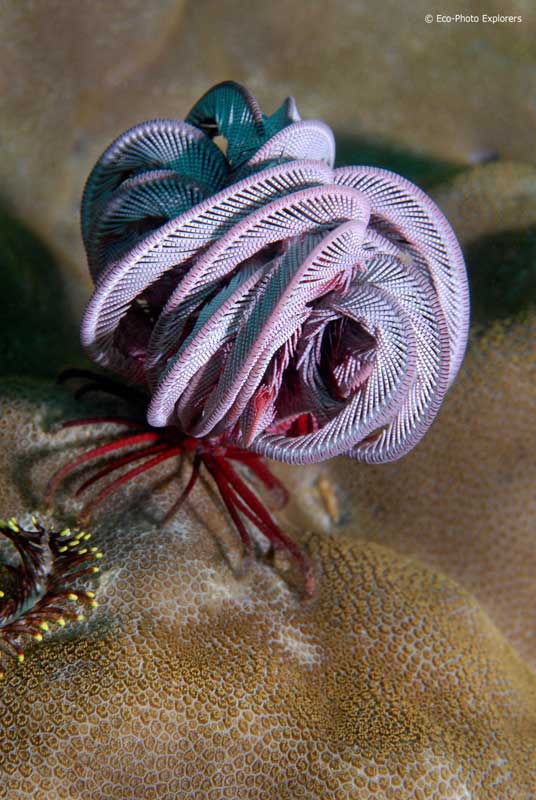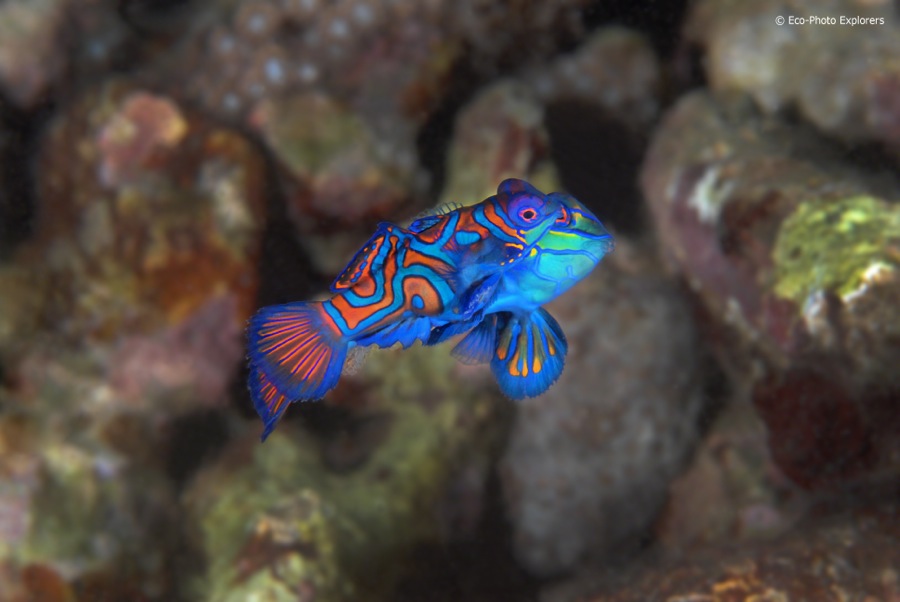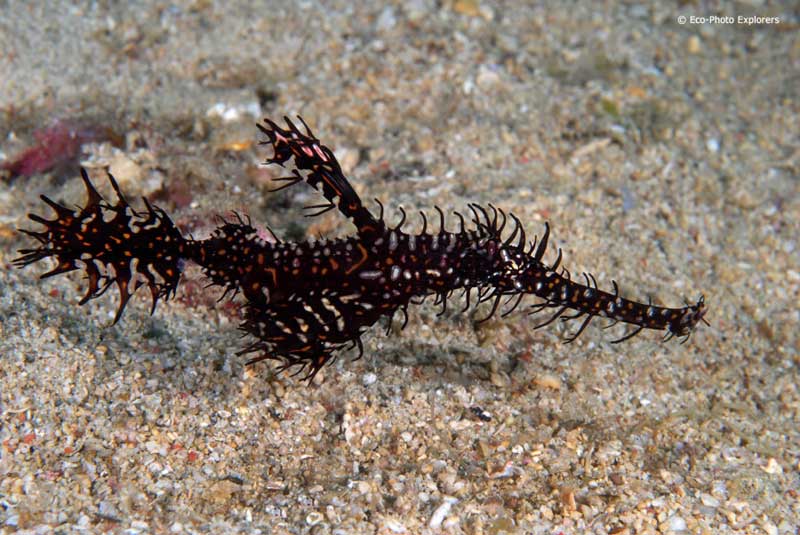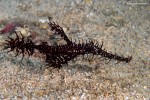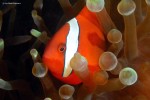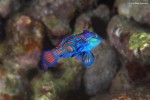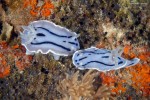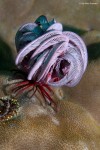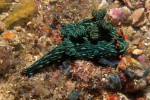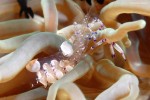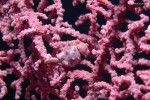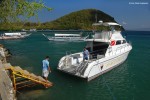The movement was barely perceptible. Did we see it or were we mistaken?
One of the first indicators of middle age is diminished eyesight but even with the best vision this was becoming a real challenge! Sitting on a sandy bottom in an increasing current at about 90 feet (30 meters), we were scouring a large pink colored sea fan. Carefully examining every inch of the contorted branches, we looked for the slightest movement…and there it was! After an excruciating search and with the help of our dive guide, Warren, we now locked in on our quarry: a pregnant Pygmy Sea Horse perfectly camouflaged to match the host sea fan. The wait was worth it as we composed several images before leaving this diminutive creature in peace to continue our dive along the reefs near Sabang in the Philippines.
The Philippines, and its 7000 islands, is the world’s second largest archipelago and is located in the heart of the coral triangle, the epicenter of biodiversity in the world’s oceans. We were here to explore the vibrant reefs of Puerto Galera in the Oriental Mindoro region, and to visit one of the most spectacular scuba diving spots in the area, Verde Island.
———————————————————————————————————————————-
Story and photos by Michael Salvarezza and Christopher P. Weaver
———————————————————————————————————————————-
Our first scuba dives were near the town of Sabang and we were delighted to find healthy coral outcroppings, and a dizzying array of dazzling reef fish. For example, at a dive site known as Monkey Beach we were instantly enraptured by the playful antics of the numerous species of anemonefish we found there. A little further to the east, Sinandigan Wall introduced us to a large Hawksbill Turtle and a robust Cuttlefish, as well as a plethora of vividly colored nudibranchs and other tiny macro subjects. The reefs of this area are also home to countless numbers of Crinoids, which come in seemingly endless varieties and color patterns. We were surprised to see that at times they appeared to blanket the bottom. Although they are usually found crawling on the bottom or along coral heads, divers will occasionally see them swimming in mid-water. Be careful as you swim near these critters…they love to hitchhike on unsuspecting divers who accidently brush against them!
Speaking of things to look out for, we wondered if there were any real marine dangers in the Philippines. Divers will undoubtedly spot the venomous Lionfish on any number of dives, as well as the poisonous Stonefish lying in wait on the reefs. Occasionally, a Banded Sea Snake will slither its way between divers, a well-known marine predator that can kill a man with its bite. None of these creatures has any interest in harming human beings and if they are given the right measure of respect, divers have nothing to fear.
But the most fearsome creatures on the reefs are unlikely ones: Get too close to the lair of the resident Damselfish or the Black Clark’s Clownfish and divers risk an attack. These small reef dwellers, measuring no more than 3-inches in length, back down for no one! You might think that a six-foot diver blowing noisy bubbles and flashing a bright strobe would intimidate these fish, but you would be mistaken.
Indeed, linger too long and these fish will actually rush you and if necessary, bite! In fact, that’s what happened to us. We unfortunately, overstayed our welcome and a Black Clark’s Clownfish charged us at light speed and bit one of our ears! Trust us, getting bit on the tip of your bare ear hurts like hell…be respectful. Perhaps there is a horror movie to be made about giant mutant Damselfish in the future!
A night dive at a site known as La Laguna Point brought an encounter with the flamboyantly colored, but incredibly shy, Mandarinfish. Descending to about 25 feet (8 meters), we settled on the bottom near a pile of coral rubble as the sun was setting and began a long vigil, waiting patiently for the amorous Mandarinfish to begin their mating ritual. It took a while, but after about 45 minutes of stoic observation, the urge to mate took precedence over the reticence of the fish and we were witness to the dénouement of their proceedings. The trick, of course, is to compose, focus and properly expose an image in the dark of night of an event between two fish no longer than an inch in length that lasts no longer than 2 seconds.
Note to underwater photographers…use a focus light with a red light or red filter. The red light adds stealth for observing and photographing shy critters and fish. Bright white light usually frightens or disturbs marine life that venture out after dark.
Besides reefs swirling with marine life, divers visiting this area can also explore several interesting and photogenic shipwrecks. In March of 2003, a Philippine cargo vessel named the Almajane was intentionally sunk in about 90 feet (30 meters) of water. This 90 foot (30 meter) steel hulled ship sits perfectly upright and is now resting quietly on a sandy bottom near La Laguna. Prior to its sinking, the ship was cleaned of debris and dangerous objects, and is very safe to penetrate for divers with the right experience. Here, divers will find resident sweetlips, as well as schools of batfish, snapper and jacks, all making the Almajane their home.
About an hour’s boat ride from Puerto Galera is Verde Island. This is a special place and we knew it the moment we dipped our facemasks under the water. At Verde Island Drop-off, one of the premier dive sites in the entire region, we were immediately transfixed by the clouds of brilliantly colored Basslets that swarm over the coral heads, and by numerous Red Anthias thrown in for good measure. Indeed, Verde island is where the biodiversity of the coral triangle is on full display. Everywhere we looked, we encountered different varieties of fish too numerous to list here. The sloping reefs were cloaked with an unbelievable assortment of corals, and squadrons of surgeonfish fluttered in the current, while hawkfish, cardinalfish, blennies and gobies peeked out from every nook and cranny of the reef. Butterflyfish flitted around the coral heads searching for food, but it takes a sharp eye to find some of the tiny frogfish and expertly camouflaged reef critters that make this area their home. Indeed, we were thrilled to photograph many species of beguiling shrimp, crabs and other invertebrate life.
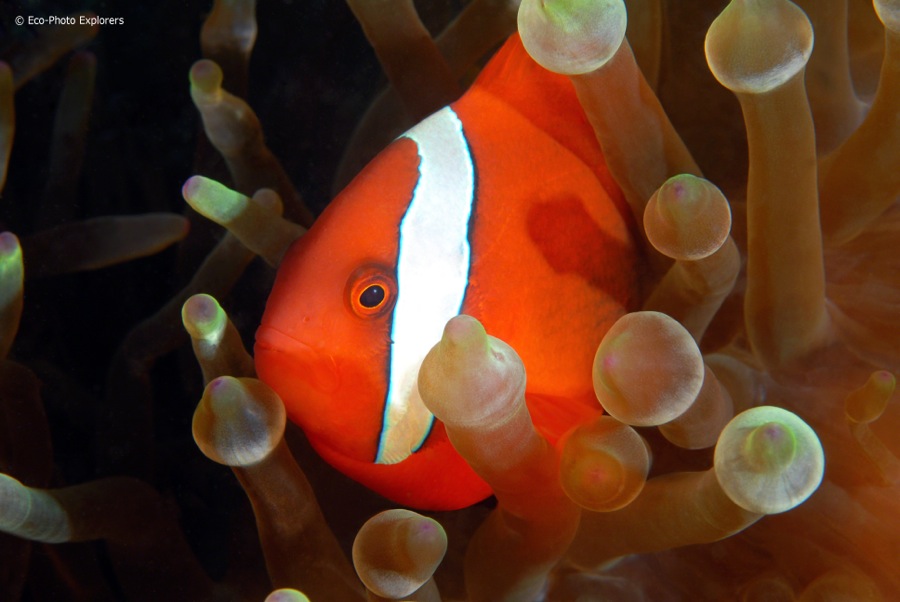
Myriad anemones and anemonefish can be found in these waters, including this Tomato Anemonefish (Amphiprion frenatus).
The Electric Fileclam is one of the more unique denizens of these coral recesses. Tucked underneath a ledge, we found several of these mesmerizing bivalves. With blazing red mantles and long flowing tendrils these clams are striking…but it is their flashing white pattern that draws our attention. Research has shown that the clam uses a thin strip of highly reflective soft tissue along the outer edge of its mantle to create the flashing pattern. By briefly exposing this strip the bivalve creates the appearance of a flashing light.
Our final scuba dive was at a site known as Secret Bay. While much of our diving in this region found us exploring lush coral gardens, riotous reef walls and shipwrecks, Secret Bay is a true muck diving experience and one not to be missed. Swimming along a nondescript sandy bottom, the treasures of the Philippines slowly reveal themselves. Nudibranchs with ridiculous color schemes are the first to appear. Next, we spot upside down jellyfish pulsating on the bottom. An Orangutan Crab lies in wait in a small pile of coral rubble. There, under a small pile of rubble is a Mantis Shrimp, ready to clobber its next prey. A tiny shrimp is perfectly hidden along a whip coral frond. Other species of delicate shrimps can be found on the undersides of tube-worms and small anemones. Starfish, sea urchins and flatworms are the welcoming committee to a fascinating encounter with an Ornate Ghost Pipefish.
Sadly, our tanks eventually ran low on air and we had to leave this special spot. Our diving in the Philippines has only whetted our appetite for more. We are certain that we have only scratched the surface of what this special corner of the world has to offer and we know that we will return, armed with a camera and an open mind.
Who knows what treasures we will encounter next time?
Spotlight on Marco Vincent Dive Resort
Located on White Beach in Puerto Galera is the Marco Vincent Dive Resort. This Mediterranean inspired property boasts 38 tastefully furnished rooms that are the most spacious in the Puerto Galera Area. All rooms are equipped with cable television, LED TV, refrigerator, A/C system, hot/cold showers and WIFI Internet connection. The resort features 3 restaurants (2 on-site and 1 beach front), an indoor pool and Jacuzzi as well as a full service dive shop located adjacent to the property.
Guests of Macro Vincent Dive Resort are taken care of the moment they arrive into the country. Representatives will personally meet guests at the airport, take them to the port at Batangas and arrange for ferry transport to Puerto Galera, which takes about 1-1/2 hours. Throughout their stay, a very cheerful, capable and helpful staff tends to the needs of resort guests.
Marco Vincent Divers currently features two dive boats: Lady Merci is a 40-foot single hull dive boat fully equipped to comfortably support the needs of divers. Big Beth is an impressive 82-foot custom equipped dive boat that can accommodate up to 28 divers on dives to Verde Island, Puerto Galera and remote locations such as Anilao. The dive center has a full complement of rental gear and offers a variety of PADI training options. It is complete with a swimming pool, classroom facilities, gear washing area, lockers and Nitrox capabilities.
Visitors to any area, including Puerto Galera, should take some time to experience more than just the sites under the water. The staff at Marco Vincent can arrange for zip line tours, treks to nearby volcanoes and waterfalls, and visits to World War II sites, including Corrigedor Island, home to a fascinating war memorial and museum.
Gallery Below: Click on photo to see a larger version
- The Giant Shrimpgoby (Amblyeleotris fontanesii) can grow as large as 6 inches in length.
- The famously shy Ornate Ghost Pipefish (Solenostomus paradoxus).
- Myriad anemones and anemonefish can be found in these waters, including this Tomato Anemonefish (Amphiprion frenatus).
- The “flashes” of the Electric Fileclam (Ctenoides ales) are mesmerizing.
- The mating of the Mandarinfish (Synchiropus splendidus)is a highlight.
- A pair of Willan’s Chromodoris (Chromodoris willani).
- Author Christopher Weaver exploring a wreck off Sabang.
- Criniods are everywhere on the reefs!
- Vividly colored nudibranchs can be found through the Puerto Galera and Verde island area.
- Look past the Anemonefish to find these Graceful Anemone Shrimp (Ancylomenes venustus) sharing the protection of the host Anemones.
- Nudibranchs, like these Tyson’s Risbecia dorids, keep macro photographers busy.
- It takes a sharp eye, or a good guide, to find the expertly camouflaged Pygmy Sea Horse (Hippocampus bargibanti).
- Hawksbill Turtles abound in these waters.
- The red variation of the Pixy Hawkfish (Cirrhitichthys oxycephalus) can be found in these waters.
- The second dive boat at Marco Vincent is the comfortable Lady Merci.
- The dive shop is steps away from the resort at Marco Vincent.
- The Marco Vincent Dive Resort in Puerto Galera has a distinctive style.
- The Marco Vincent Dive Resort dive boat Big Beth anchored at White Beach.
Getting There
The gateway city into the Philippines is Manila. Flights arrive from numerous locations around the world, with many convenient connections available through Hong Kong. From Manila, various travel options, including domestic flights and ferry services, are available to other provinces in the country.
For US visitors, a VISA is not required. If you are a citizen of another country, check the VISA requirements before planning your trip.
A valid passport is required for entry, and must be valid for 6 months after arrival.
Immunizations and Medicine
As with any travel to tropical regions, make sure all your vaccinations are up to date! All travelers should visit their personal physician or a travel health clinic to discuss what vaccinations (e.g., Hepatitis A, Hepatitis B, Malaria, Typhoid, or Tetanus-diphtheria) and travel medicine are recommended. All medicine should be packed in their original, clearly labeled containers. Having a signed and dated letter from a physician describing your medical conditions and medications is suggested.
Note: Travel health clinics usually provide more detailed health protection measures since they specialize in travel medicine. Beware of travelers’ diarrhea, which is the most common travel-related ailment. Insect protection is a must and essential!
Baggage
Baggage allowances vary for each international carrier so check before you leave.
Weather
The Philippines has a tropical climate. There are basically two seasons: the wet season (May-October) and the dry season (November-April). April and May are the two warmest months, marked by high temperatures and humidity. During these months, temperatures can reach 90 degrees F or higher. In the cooler months of December and January, temperatures moderate with less humidity.
The Philippines is in the tropical cyclone belt, and typhoons threaten the region between July and October. Typhoon Yolanda struck the southern regions on November 8, 2013, with devastating results. The damage and affects were limited to the south, however, and Puerto Galera and Verde Island were not affected in any way.
Currency
The local currency is the Philipino Peso but US Dollars are often accepted at all resorts.
Electricity
Power voltage used in the Philippines is 220 Volts (50 Hz). Be sure to double-check your appliance’s compatibility before plugging them in. Converters / adaptors are usually available upon request at your hotel front desk. Travel Adapter: Round Pin Universal Plug
———————————————————————————————————————————-
Story and photos by Michael Salvarezza and Christopher P. Weaver
———————————————————————————————————————————-
.

